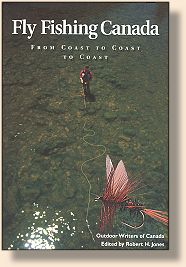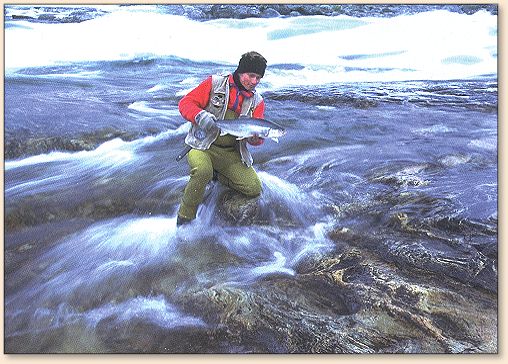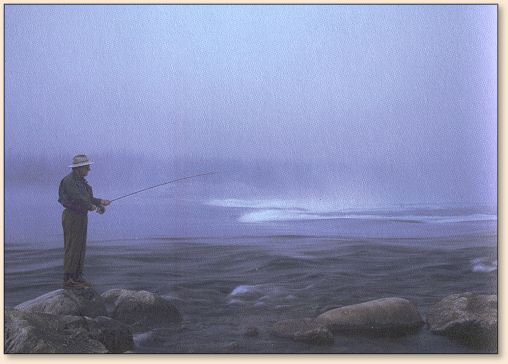Fly-Ins, Part 6
By Dr.Martin Lamont
From Fly Fishing Canada From Coast to Coast, Published
by Johnson Gorman Publishers. We appreciate use permission.
Northwest Territories - Piscatorial Penultimate
Visitors to the Yellowknife Airport are familiar
with the large mural of an inuskuk
painted by Ontario artist Ken Kirkby, an avid angler
and steelheader. The inuskuk is symbolic
of the arctic tundra, a stone way-marker for ancient
and modern travelers. Coincidentally, its protruding
arms closely resemble the shape of an aircraft, leading
one to wonder if the ancients foresaw the day when air
travel would dominate transportation in the north.

Although enjoyable, my visits to Yellowknife often made
me feel the need to leave the large hotel's comfort for
some outpost camp. It is only a short downhill walk
from the city center to the lakeside floatplane staging
area. Morning rush hour is evident as floatplanes await
their turn to take off for points west, north and east.
It was a sunny morning when my teenage son and I left
Yellowknife for a three-hour charter flight into the
central coastal Arctic. We flew over an extensive
expanse of forest which eventually gave way to a
seemingly endless blanket of tundra, sun-dimpled by
countless lakes and rivers. Our bird's-eye view
enhanced the sinuous eskers, scoured glacial bedrock
and drumlins, pointing out the path of an ancient,
vanished ice field.
 On previous trips we had successfully caught lake trout,
graying and freshwater char on flies. This time our tent
camp was located on high ground near a sizable coastal
river. After disembarking on the gravel beach, we met
with the camp boss, who had spent most of his working
life in the Canadian Arctic, and his Inuit assistants.
Leisurely, we discussed our strategies, for there was
no rush to go fishing in the northern summer when day
merges into the twilight of night only briefly. Arctic
char was our target species, and I reflected on the
Inuit wisdom of following the rhythm of the seasonal
timetable. After the inland passage of migrating
caribou herds, the Inuit headed for the coast to
make a fishing camp at the same site. They were
good fishermen. As soon as the river is free of ice,
char that have overwintered in fresh water head downstream
to salt water, and then later in the year, other year-classes
of large, anadromous arctic char return to the river to spawn.
On previous trips we had successfully caught lake trout,
graying and freshwater char on flies. This time our tent
camp was located on high ground near a sizable coastal
river. After disembarking on the gravel beach, we met
with the camp boss, who had spent most of his working
life in the Canadian Arctic, and his Inuit assistants.
Leisurely, we discussed our strategies, for there was
no rush to go fishing in the northern summer when day
merges into the twilight of night only briefly. Arctic
char was our target species, and I reflected on the
Inuit wisdom of following the rhythm of the seasonal
timetable. After the inland passage of migrating
caribou herds, the Inuit headed for the coast to
make a fishing camp at the same site. They were
good fishermen. As soon as the river is free of ice,
char that have overwintered in fresh water head downstream
to salt water, and then later in the year, other year-classes
of large, anadromous arctic char return to the river to spawn.
 Using heavy 8-and 9-weight rods with fast-sinking lines,
we cast No.6-2/0 streamer flies - Polar Shrimps, Mickey
Finns, Marabou Streamers, Woolly Buggers in orange,
chartreuse, and silver and blue. These flies
attracted fresh, fighting, sea-run char. They
took gently and rarely jumped, but they ran - deep
and fast like silver torpedoes - and did not give up
easily. We were occasionally blanked when the fish
went off the bite, but never for long. The runs in
that area are strong and large in volume. The world
record of 32 lb 9 oz (14.8 kg) was caught just 125
miles (200 km) north, and it will be broken. It
is only a matter of time. ~ ML
Using heavy 8-and 9-weight rods with fast-sinking lines,
we cast No.6-2/0 streamer flies - Polar Shrimps, Mickey
Finns, Marabou Streamers, Woolly Buggers in orange,
chartreuse, and silver and blue. These flies
attracted fresh, fighting, sea-run char. They
took gently and rarely jumped, but they ran - deep
and fast like silver torpedoes - and did not give up
easily. We were occasionally blanked when the fish
went off the bite, but never for long. The runs in
that area are strong and large in volume. The world
record of 32 lb 9 oz (14.8 kg) was caught just 125
miles (200 km) north, and it will be broken. It
is only a matter of time. ~ ML
Dr. Martin Lamont's Must-Have Patterns for Fly-Ins
- Fry or Alevin patterns
- Glennies Green' n' Silver
- Hellgrammite
- Mickey Finn
- Polar Shrimp
- Purple Egg-Sucking Leech
|
Credits: Excerpt and photos from Fly Fishing
Canada written by Outdoor Writers of Canada,
edited by Robert H. Jones, Published by Johnson
Gorman Publishers. Used with permission.
Our Man In Canada Archives
|





